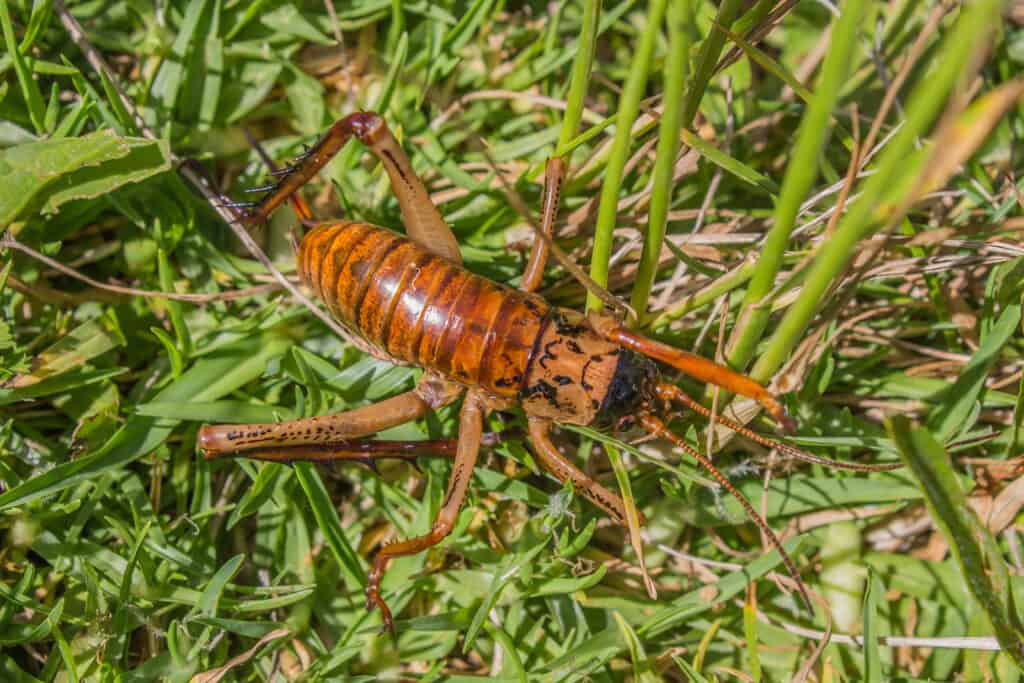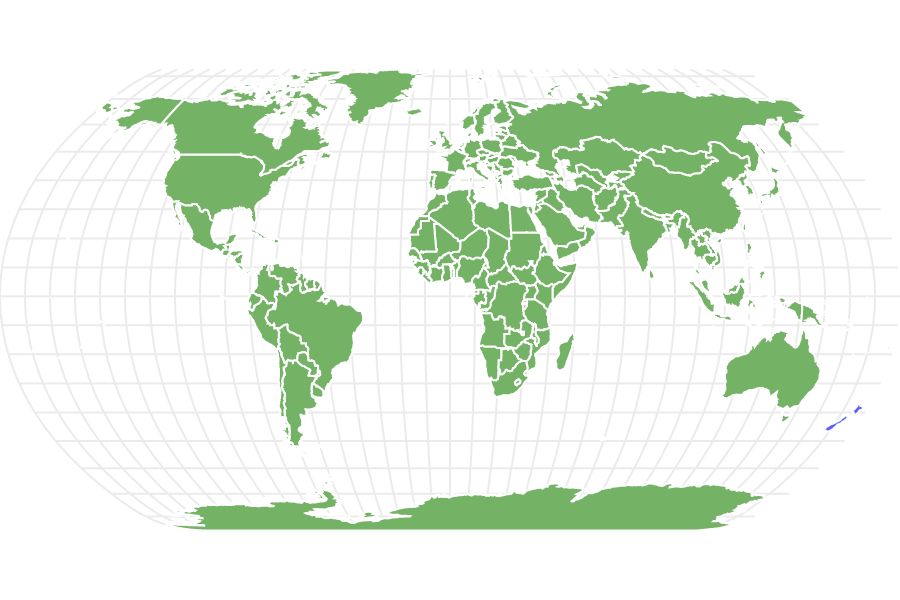Giant Weta
Deinacrida
They've been around for 190,000,000 years!
Advertisement
Giant Weta Scientific Classification
- Kingdom
- Animalia
- Phylum
- Arthropoda
- Class
- Insecta
- Order
- Orthoptera
- Family
- Anostostomatidae
- Genus
- Deinacrida
- Scientific Name
- Deinacrida
Read our Complete Guide to Classification of Animals.
Giant Weta Conservation Status
Giant Weta Facts
- Prey
- Mainly leaves, but can include some smaller insects.
- Group Behavior
- Group
- Fun Fact
- They've been around for 190,000,000 years!
- Biggest Threat
- Rodents, habitat destruction by humans
- Most Distinctive Feature
- 4 inch bulky body
- Other Name(s)
- wetapunga
- Gestation Period
- 8 months
- Litter Size
- 200-300 eggs
- Habitat
- Shrublands, forests, grasslands, caves
- Predators
- Rats, hedgehogs, cats, mustelids
- Diet
- Omnivore
- Lifestyle
- Nocturnal
- Group
- Type
- Herbivorous Orthoptera
- Common Name
- Giant Weta
- Number Of Species
- 11
- Location
- New Zealand
- Group
- yes
Giant Weta Physical Characteristics
- Color
- Brown
- Green
- Black-Brown
- Lifespan
- 2.5 years
- Weight
- 1.2 oz
- Length
- 4 inches
- Age of Sexual Maturity
- approx. 2 years
- Venomous
- No
- Aggression
- Low
View all of the Giant Weta images!
The Giant Weta is a type of weta insect only found and restricted to New Zealand. Although the Weta is itself quite a large insect, some species of Giant Weta are the largest insects in the world. Resembling a grasshopper, the Giant Weta has been around since the age of dinosaurs and is known to have existed before some species of dinosaurs even set foot into the world. It is mainly nocturnal, one of the reasons why it has survived for millions of years.
Giant Weta Species, Types, and Scientific name
Giant Weta are also referred to as wētāpunga. Its scientific name, Deinacrida, comes from the North of North Islands in New Zealand known as Te Ika-a-Māui among the locals. The name translates into demon or terrible locust in the Maori language. It comes from the order Orthoptera and the family Anostostomatidae.
Some species of Giant Weta are now endangered. There have been many studies and projects carried out to increase its population but they remain an easy target of many predators. Today, they remain restricted to only one island in New Zealand.
A Giant Weta is easily recognizable due to its huge cricket-like body, which may be equivalent to a mouse if weighed. They have a narrow upper body region but long and curvy legs. Giant Weta have enlarged, spiny, hind legs and are mostly wingless. Giant Weta can thrive in many different environments, including alpine, forests, grasslands, caves, shrub lands and gardens.
How Many Giant Weta Species Are There?
There are 11 known species of Giant Weta. Most of these insects grow up to be larger than the Weta species, which are 70 in number. The 11 species of Giant Weta are of various kinds:
- Deinacrida carinata (Herekopare wētā)
- Deinacrida connectens (Scree wētā)
- Deinacrida elegans (Bluff wētā)
- Deinacrida fallai (Poor Knights giant wētā)
- Deinacrida heteracantha (Little Barrier Island giant wētā)
- Deinacrida mahoenui (Mahoenui giant wētā)
- Deinacrida parva (Kaikoura giant wētā)
- Deinacrida pluvialis (Mt Cook giant wētā)
- Deinacrida rugosa (Cook Strait giant wētā)
- Deinacrida talpa (Giant mole wētā)
- Deinacrida tibiospina (Mt Arthur giant wētā)
Appearance: How To Identify Giant Weta?
Eggs
The female Giant Weta can carry as many as 200 to 300 eggs in their whole life. They are present in its belly and are cigar-shaped. They lay these eggs into the soil using a female organ known as the ovipositor. After 8 months, the hatchlings come out resembling adults.
Instars
Hatchlings that are formed are called instars. After 11 instars or molting their exoskeleton, Giant Wetas eventually reach adulthood in nearly 2 years. Molting their exoskeleton helps them to become their giant size. Most of Giant Weta only live for roughly 6 to 9 months after reaching adulthood. After 2 years, they reach the age of sexual maturity and mate.

The Giant Weta is the largest insect on Earth.
©Viktor Hejna/Shutterstock.com
Adults
A Giant Weta may resemble a cricket but it is the largest insect on Earth. An easy identifier for finding Giant Weta is that they carry a smelly odor. They are around 4 inches in length and weigh around 1.2 ounces. However, the females are larger than the males and may weigh as much as a small sparrow.
Giant Wetas are blackish black or brownish green in color which helps them stay hidden in their surroundings. They have a shorter upper body region and a much bulkier lower body region. Its body is covered in an exoskeleton which helps it to breathe like all other insects. It also has a pair of antennas and an innocent-looking face.
As for its locomotion, it usually travels on foot. Although the wetas can jump as high as 6 feet, Giant Wetas are too heavy to stay in the air or jump constantly. They can run using their long and slender legs but often it is not enough to help them escape their predators. Some of the legs have spine-like structures.
An interesting thing about their ears is that they are on their knees. You can spot them as holes on the front legs near the knee joints. This is to help them widen their range of hearing. When they spread their legs, even the smaller Giant Wetas can hear from a farther distance.
The largest Giant Weta to have been recorded up till now measured up to 4.3 inches in length and could spread its legs to 7 inches wide.
Behavior
Giant Weta are not aggressive and mainly nocturnal. They tend to live together in small groups near their natural habitat. Weta have evolved along with native predators such as birds, reptiles and bats. However, their population is declining at a fast rate due to introduction of rodents, cats and hedgehogs.
It is worth noting that the females can become aggressive while carrying eggs. Giant Weta bites are rare but can be painful. These mostly passive insects spend most of their time eating or, in the case of adults, mating. The males can travel over 800 feet per night in search of a companion.
Habitat: Where to find Giant Weta?
Giant Wetas are only found in New Zealand. Even in New Zealand, they were spread across Auckland, Great Barrier Island, and Northland. But now there is only one group of the Giant Weta left in the world in the Little Barrier Island, also known as Hauturu-o-Toi.
Since they come out at night, they stay hidden under bushes during the day. You can spot them in a variety of obscured places like grasslands, shrublands, forests, and even caves. Through digging, they can make holes under stones and trees which further aids them in hiding. If an existing burrow is available, you can find them there as well.
Has Giant Weta Become Extinct?
The Giant Weta is an endangered insect whose population is greatly declining. The reason for their decline is that New Zealand was not once populated as it is today. There are non-native mammals that eat the Giant Weta and humans that can destroy their habitat.
All in all, they cannot even hide anymore due to their large size, causing them to go near-extinct. However, people have been trying to protect what little of them are left now.
Scientists have been producing backup populations of Giant Weta as a tradeoff. Through this process, they aim to preserve smaller communities of Giant Weta if one dies due to a catastrophe.
In 2011, around 25 adults of Giant Weta were released into Tiritiri Matangi Island, and 12 were released into the Hauturu o Toi in 2012. As a result, in 2013, baby Giant Wetas were hatched from eggs called instars. Similarly, in 2014, adults or premature Giant Wetas were released into the island of Tiritiri Matangi.
Many small and large groups were released into a bunch of islands in New Zealand. Apartments of bamboo were built to keep them near or around these habitats for monitoring purposes.
Diet: What do Giant Wetas Eat?
Their diet is mainly herbivorous but they can also eat other smaller insects. You can find them munching on fresh leaves and plants that are found near their habitat. In 2011, the Giant Weta was also discovered eating some carrots which may sound unusual but is a common food for many insects. A Giant Weta may eat large leaves like the karaka, karamu, māmāngi, māhoe, and kohekoh.
What Eats Giant Weta?
There are a lot of threats to a Giant Weta since they are not good at escaping. But mice, cats and other rodents are one of their biggest predators.
Up next…
Take a look at a few of our other articles to learn more about some amazing insects.
- Mega Bugs Find out what kind of giant bugs used to roam the earth.
- Giant Leopard Moth – No, it’s not a bird or a plane, it’s probably this moth.
- Asian Giant Hornet – Read on to find out why they call it the murder hornet!
Giant Weta FAQs (Frequently Asked Questions)
Can Giant Weta Bite?
Although the Giant Weta is not an aggressive insect, its weta cousins may bite if provoked.
Are Giant Weta dangerous?
No, they are passive insects that tend to hide during the day. They are herbivores and do not harm humans unless provoked during the breeding season.
How many legs does Giant Weta have?
They have three pairs of legs, one on the front, one in the middle region, and one on its back.
How do you identify Giant Weta?
They appear a cross between a grasshopper and a cricket. They are brownish green or blackish brown in color and have a bulky body.
Where is the Giant Weta found?
They are found only in New Zealand.
Thank you for reading! Have some feedback for us? Contact the AZ Animals editorial team.
Sources
- D.O.C. NZ, Available here: https://www.doc.govt.nz/nature/native-animals/invertebrates/weta/giant-weta-wetapunga/
- Wikipedia, Available here: https://en.wikipedia.org/wiki/Giant_w%C4%93t%C4%81
- Mental Floss, Available here: https://www.mentalfloss.com/article/64804/10-intense-facts-about-giant-weta
- Science Line, Available here: https://scienceline.org/2020/08/giant-weta/
- Zealandia, Available here: https://www.visitzealandia.com/About/The-Wildlife/Reptiles-Frogs-Invertebrates/Cook-Strait-Giant-Weta
- Wired, Available here: https://www.wired.com/2015/06/absurd-creature-of-the-week-weta/

















